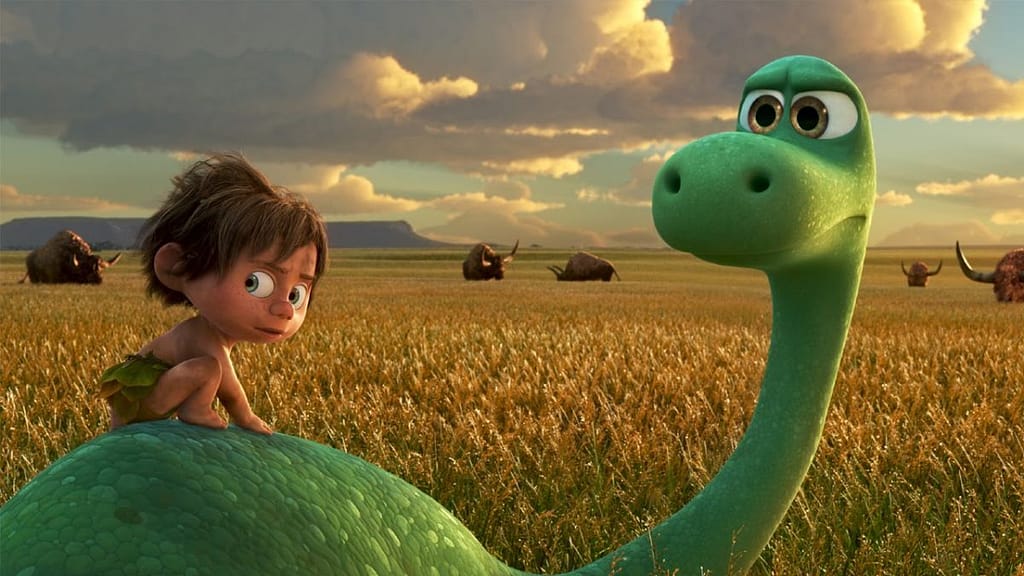Pixar has a way of tugging at our heartstrings. Since it’s earliest feature “Toy Story” back in 1995, Pixar has only gotten better at sharing stories that resonate with audiences. Currently, Pixar released the newest addition to their list of films, “Toy Story 4” and with so many new sequels and original ideas yet to come in the next few years from them, we wanted to rank our top 7 favorite Pixar movies that include themes of Mental Health. WARNING: If you haven’t watched the films then don’t read ahead! SPOILER ALERT.
- The Good Dinosaur

This is one of those Pixar films that divided the critics. Many felt that it was missing that certain magic seen in other Pixar films, while others thought that it was another hit! Whatever the case is, The Good Dinosaur made it on our list because it dealt with issues of loss/grief and anxiety. Set in a parallel universe where dinosaurs never went extinct and instead evolved, this film creates a twist where humans coexist as the less developed creature. The story of the film revolves around Arlo, an apatosaurus who is born a runt to a small family of farmers. Due to his small size and perceived “fragile” nature, Arlo struggles with anxiety. At the beginning of the film, we see Arlo trying tirelessly to fit in with his family. Unlike his siblings who excel and leave their mark on the family monument, Arlo struggles.
As the film progresses, Arlo’s father tasks him with “getting rid of” a pest who has been eating their harvest. Arlo’s father makes it clear that completing this task will ensure Arlo’s place on the family monument. Arlo, ecstatic about the opportunity, gets ready to fulfill what is asked of him. When he finally catches the pest (a small human named Spot), Arlo is unable to hurt him. Instead, Arlo releases Spot and is lectured by his father who watches from nearby. As Arlo and his father chase after Spot, a storm begins to develop, and a massive flood kills Arlo’s father. Lost, confused, anxious, and stricken with grief, Arlo begins an adventure to find his way back home that includes grieving his loss, coping with anxiety, and forgiving/ befriending Spot.
- COCO

PIXAR has a reputation for creating quality animation with fantastic storylines. This is absolutely one of our favorite animated movies, not just because of the great music, but because it’s one of the first animated films focused on a Latinx family. The film takes place in a fictional Mexican town where a family of shoemakers has banned music from their lives due to past family trauma. Miguel, the main character and one of the younger members of the family, has a fascination with music. Unfortunately for him, his family continuously discourages his love of music and pushes him to follow the family shoe business. During a moment of discovery, Miguel finds clues indicating that he may be related to his favorite deceased musician, Ernesto de la Cruz, who happens to be the most beloved singer in all of Mexico.
When Miguel reveals his discovery to his family, his grandmother becomes upset and smashes his guitar. Miguel, intent on proving that he has music in his blood, attempts to steal his supposed “Great Grandfather’s” prized guitar from his gravesite. When he finally does grab the guitar, his adventure begins. It’s a journey filled with magic, mystery, and self-discovery. Along the way, Miguel learns about the meaning of family while learning about loss, honoring ancestors, and healing. This is one PIXAR movie you don’t want to miss, and it will definitely bring the tears, so make sure you have some tissues ready!
- Up

Up is one of the Pixar Animation films that have stuck with me since the first time I saw it. At the beginning of the movie, you are introduced to a young couple whose names are Carl and Ellie, and the viewer is told their story without any words being spoken. Both Carl and Ellie idolized the explorer Charles Muntz and wanted to travel to Paradise Falls in South America. When they got married, they set up a glass jar in their living room, with Paradise Falls written on paper and taped onto the jar. This was their dream jar, and every day, they would add their spare change to it. Every time the jar was close to getting full, they would have to break it because an expense came up that they were not prepared for. As a couple, they experienced many challenges, including the loss of a child. During this challenging time, Carl brought out their adventure book and was able to give Ellie the support she needed. Before Ellie Passed away, she passed their adventure book to Carl. This scene was very symbolic because their life together was their adventure, all the simple moment’s that they experienced together. At the end of the book, Ellie had written, ‘Thanks for the adventure, now go have a new one.’ After Ellie’s passing, Carl continues on to eventually complete Ellie’s dream of visiting Paradise Falls.
When Carl has the courage to leave, he takes the house with him. Personally, I feel that the house is symbolism for Carl’s grief. He is still in the process of mourning and is not sure how to continue on without Ellie by his side. Little does he know that someone else is going to take the journey to paradise falls with him. Russell comes into Carl’s life needing to earn one last badge, ‘assisting the elderly.’ The role Russel plays in Car’s journey is vital. Russel was there to act as a guide for Carl as he entered the next phase of his journey. Carl also has to learn again how to trust and rely on another individual. Throughout the movie, Carl is taking the house with him from one place to another. When Russell runs away, Carl is forced to get rid of things to make the house lighter. While doing this, Carl is letting go of many of the physical items that they shared together. He places the furniture and other household items on the ground at Paradise falls, and eventually the house, completing Ellie’s story.
- Inside Out(Depression/Adjustment Disorder)

When Inside Out was first announced, many people were curious about the film’s premise. After all, how can we portray emotions inside out hear? Well, Pixar had the perfect answer, and the film went on to win numerous awards, received critical acclaim, and was praised by mental health professionals everywhere! One of the major draws of the film involves the way in which emotions are portrayed by adorable bright colored characters, each with their own purpose. The character design, along with the talented voice cast, made Inside Out an entertaining and family-friendly spectacle.
The film is about an 11-year-old girl named Riley, who moves from her quiet and happy home in Wisconsin to San Francisco, CA because of her father’s thriving career. This significant life change causes Riley to slowly become emotionally distraught as the film progresses, leaving her emotions; joy, anger, fear, sadness, and disgust continuously attempting to help her make the transition. The film was not only a funny and imaginative way of displaying the basics of how our emotions work, but it was very touching and brought some serious themes into play. For Riley, moving from her home meant leaving behind her world and caused her to begin displaying a complex cycle of emotions. Many of these emotions manifested into behaviors that she barely understood and caused her parents grief. Throughout the film, the viewer can see the conflict happening between the emotions inside her head and also a view of how it manifests in the real world and the repercussions they bring about.
This film is a great way to help any child learn about how emotions play a role in our development. It also helps normalizes difficult situations and challenges involved in growing up. The film made me question a lot of my own personal memories and really made me wonder about the meaning of letting go and how we are shaped through our experiences. I think the film did an excellent job not only catering to children, but also to adults because of the dialogue and the emotional themes introduced. The film really dwells a lot on the memories that shape us as people and does a good job describing core memories and the influence they have on our personality. Throughout the movie, Riley’s inner world begins to fall apart, and her behavior, as well as personality, change dramatically. The emotional turmoil begins to manifest in the disappearance of her imaginary friend and the destruction of her fantasy world. The movie also touches various dark themes. Riley becomes so homesick that she decides to run away, steal, and even lies to her parents. Inside Riley’s head, the emotions all begin to fight for control, and Joy begins to understand the purpose of sadness in Riley’s life. The movie gives great insight into the meaning of sadness and our ability to overcome and conquer the difficult times in our lives. I think that children who have a difficult time expressing their feelings would benefit from watching this film because it teaches them the basics of emotions. The main character is also relatable, and many children would most likely identify with her.
- Finding Nemo

Finding Nemo is a story about a family of Clownfish living in the great barrier reef. Marlin and Coral were excited about finding a spot on the reef that was ideally suited for raising a family. During their excitement, a larger fish swims into the reef and Coral is faced with a difficult decision, does she save herself or her children that are not yet fully developed. In a split of the moment decision, Coral decided to swim to her children and ends up losing her life in the process. While this is happening, Marlin tries to swim after Coral but is knocked unconscious by the larger fish. When he wakes up, Marlin is in a state of crisis. He is swimming frantically, first looking for Coral and then looking for the eggs. Marlin looks down, and for a moment, he thought that none of the eggs survived, but as he swam into the opening, he realized that there was one egg that was still alive. Marlin states, ‘There, there, I won’t let anything happen to you, Nemo.’ Marlin’s focus in life becomes about keeping Nemo safe. Marlin approaches the world from a perspective of fear and concern, while Nemo views the world with excitement and curiosity.
Children have a natural sense of wonder in regards to the world around them. It is a normal part of development to test limits and to begin to explore and learn outside of the confines of the parental relationship. Marlin knows in the back of his mind that Nemo is getting older, but at the same time, he wants to protect him from the world. His understanding of the world being a dangerous place is emphasized throughout the beginning of the film. The normal process of differentiation is challenging because Marlin is in a constant state of fear of the world around him. Because Marlin and Nemo are growing both individually and collectively, they reach a point of crisis, and this is where their individual journeys begin. In the act of rebelling Nemo swims into the open ocean and is captured by a diver who is scuba diving in the reef.
Marlin and Nemo are ultimately on the same journey with different timelines in that they are both working to find themselves and then find each other. While following the boat, Marlin meets Dory and has a companion for the journey. Dory has a childlike innocence that helps Marlin begin to connect with parts of himself that have been pushed down. Even though he was afraid, he had to keep going because his love for his son was more important and stronger than his fear of what was beyond the reef. In the fish tank, Nemo is also given an opportunity to experience life aside from his father and enter into a family that will prepare him for the next steps on his journey. Many themes around mental health are brought up in this film. Marlin experiences a complex trauma at the beginning of the film that affects his presentation and interpersonal relationships on every level. One scene that really stood out to me was when he was dropping Nemo off at school for the first time. When he is introduced to the other parents, he tells them that he is a clownfish and they ask him to tell them a joke. Marlin struggles with his words and has a hard time connecting with others. At the end of the film we are encountered with the same scene, and Marlin is able to tell the joke, connect with other parents, and share a laugh with them at the same time. It takes the journey of Finding Nemo for Marlin to find himself. By venturing out of what he was familiar with, Marlin was able to get new perspectives and establish new connections at the same time.
Marlin:
“I promised I’d never let anything happen to him.”
Dory:
“Hmm. That’s a funny thing to promise.”
Marlin:
“What?”
Dory:
“Well, you can’t never let anything happen to him. Then nothing would ever happen to him. Not much fun for little Harpo.”
Luis is a Licensed Marriage & Family Therapist who graduated from Long Beach State University with a Masters degree in Counseling Psychology (2015). He also has a Bachelors's degree in Child and Adolescent Development with an emphasis on Public Policy from San Francisco State University (2011). Luis has over 9 years of experience working with children and families both in education and mental health. Previously, Luis worked for a non-profit agency in San Francisco, CA providing mental health consultation in early head start programs and SFUSD pre-schools. Currently, Luis works at Kaiser in San Francisco providing mental health services.
His therapeutic interests include working with Trauma, the LGBTQ community, Children, Families, Couples, and POC. His personal interests include; Films, Reading, Writing, Art, Travelling, Disney, and Food. He is also a recipient of the California State Stipend award (2015). PsychoSocial is part of Luis' dedication to mental health and an example of his passion to educate others. Luis hopes that through PsychoSocial he will be able to help in the fight to end the stigma around mental illness.
#EndtheStigma
-
Luis Cornejo, LMFThttps://psychosocial.media/author/psychosocial/September 18, 2017
-
Luis Cornejo, LMFThttps://psychosocial.media/author/psychosocial/January 28, 2018




















